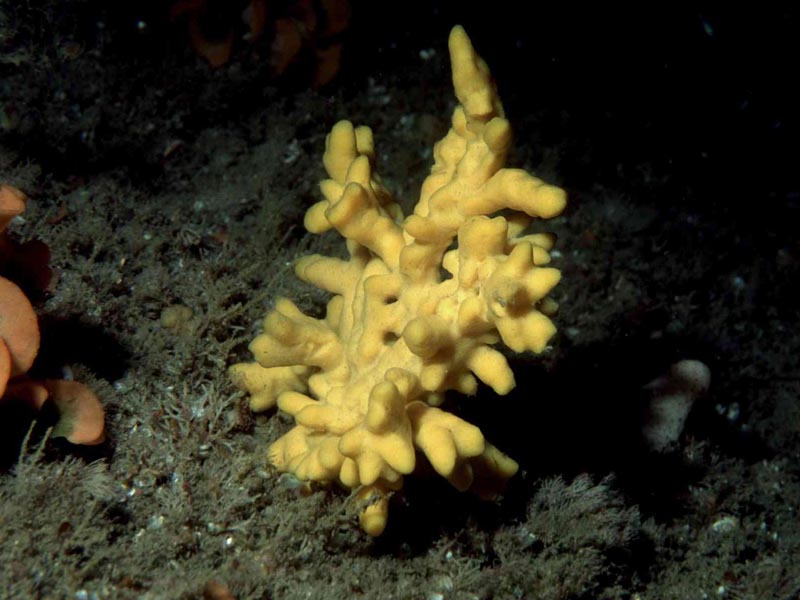A sponge (Homaxinella subdola)
Distribution data supplied by the Ocean Biodiversity Information System (OBIS). To interrogate UK data visit the NBN Atlas.Map Help
| Researched by | Al Reeve | Refereed by | Admin |
| Authority | (Bowerbank, 1866) | ||
| Other common names | - | Synonyms | Homaxinella subdola , Homaxinella subdola (Bowerbank, 1866), Axinella subdola |
Summary
Description
This species can range between pale, brownish or golden yellow to an orange or deep orange colour. Growing to 25 cm in height, Homaxinella subdola consists of a wiry stalk with rounded branches arising irregularly at right angles to the main stem. Secondary branching gives the sponge an 'untidy' appearance. The exhalent pores (oscules) are small and appear sporadically on the branches.
Recorded distribution in Britain and Ireland
Restricted to south and west coasts with records from Plymouth, the Scilly Isles, Milford Haven, Skokholm Island, Skomer Island and Abereiddi Bay.
Global distribution
-Habitat
Present on horizontal and slightly inclined rock covered with a layer of silt in sheltered and semi-exposed conditions. Also present in sheltered conditions in exposed areas, e.g. sheltered bottom plains or the bottom of gullies.
Depth range
-Identifying features
- Pale, brownish or golden yellow to orange or deep orange branching sponge.
- Thin, irregular branching resulting in an 'untidy' appearance.
- Rounded branches arise, usually, at 90° to the main stem.
- Wiry stalk.
Additional information
Similar species in appearance are Axinella polypoides and Haliclona oculata. However the presence of branches growing at right angles, a wiry stalk and an 'untidy', bushy form are characteristic of Homaxinella subdola. Adreus fascicularis is also similar but generally smaller, more wiry and has a more tidy appearance. The composition of the internal skeleton (i.e. the spicules) are important taxonomic characteristics (see van Soest et al., 2000 for details). As with other Axinella species, Homaxinella subdola is extremely slow growing and does not colonize artificial reefs (K. Hiscock pers. comm.).
Listed by
- none -
Bibliography
Howson, C.M. & Picton, B.E. ed., 1999. The species directory of the marine fauna and flora of the British Isles and surrounding seas. CD-ROM Edition. Ulster Museum and The Marine Conservation Society, Belfast and Ross-on-Wye., Belfast: Ulster Museum. [Ulster Museum publication no. 280.]
JNCC (Joint Nature Conservation Committee), 1999. Marine Environment Resource Mapping And Information Database (MERMAID): Marine Nature Conservation Review Survey Database. [on-line] http://www.jncc.gov.uk/mermaid
Moss, D., & Ackers, G. (eds.), 1982. The UCS Sponge Guide. Produced by R. Earll. Ross-on-Wye: The Underwater Conservation Society.
Van Soest, R.W.M., Picton, B. & Morrow, C., 2000. Sponges of the North East Atlantic. [CD-ROM] Windows version 1.0. Amsterdam: Biodiversity Center of ETI, Multimedia Interactive Software. [World Biodiversity Database CD-ROM Series.]
Datasets
NBN (National Biodiversity Network) Atlas. Available from: https://www.nbnatlas.org.
OBIS (Ocean Biodiversity Information System), 2025. Global map of species distribution using gridded data. Available from: Ocean Biogeographic Information System. www.iobis.org. Accessed: 2025-08-08
Citation
This review can be cited as:
Last Updated: 30/06/2005



